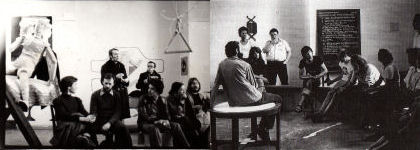a project by Waldo Bien, FIU-Amsterdam

Fotos Klaus Tesching, Klasse Beuys 1971-1978
Joseph Beuys was appointed in 1961 with unanimous decision of the academy board to the " Chair of Monumental Sculpture of the National Academy of Arts Duesseldorf " and started as a successor to Sepp Mages at his officeon the 1st November. Among his students had been Jörg Immendorff, Johannes Stüttgen, Imi Knoebel and Walter Verwoert.
Room 20 formed Beuys classroom. Beuys stayed professor at the academy of arts from 1961 until 10th October, 1972, the day on which he was discharged by the education minister Johannes Rau, for political reasons. Together with his students Beuys occupied the secretary's office to contest the decision about the enrolment of students who have been refused admittance. He refers to a previous senates decision which states that every teacher has the right to admit as many students to his, or, here, class as hey, or she, sees fit. The sacking of Beuys is the beginning of a long legally and ideological dispute which is finally settled in favour of Beuys, with a judgement handed down at the highest legally level.
The class of Beuys has several classrooms or working spaces at its disposal. Classroom 20 is one of the largest and becomes a central meeting place. This place turned out to be the site of transformation for a whole generation of outstanding artists - Sigmar Polke, Tadeus, Blinky Palermo, Katharina Sieverding, Reiner Ruthenbeck, Jörg Immendorf, Lothar Baumgarten, Immi Knoebel, Michael Rutkowsky, Anatol, Walter Dahn, Felix Droese, Johannes Stüttgen, Anselm Kiefer, and thus on.
The of weekly' group discussions' in which everyone is seated in a circle and accessible to everyone attracts a very various audience, especially on Friday, they are eagerly awaited meetings that no one likes to measure, and everyone is invited to make in active contribution, either in the form of a work, by commentary, suggestions or participating in the discourse.
These discussions in Beuys classrooms in the late 60th and the early70s established the background of the presentation of a new art concept: THE SOCIAL PLASTIC or the EXTENDED ART CONCEPTION.
In Duesseldorf several factors allowed an end of the old art categories and a radical fresh start gathered in the beginning of the 60s. The Fluxus-concerts and Fluxus-actions originating from Joseph Beuys and Name June Paik since 1961/62 had already sprinkled the frame of the traditional types. Robert Morris arrived in October, 1964 to Duesseldorf, exhibited in the Gallery Schmela and performed as a friend of Beuys together with Yvonne Rainer at the academy.
In the 60s, Duesseldorfs Academy of Arts was in the centre with Joseph Beuys, an important action centre from which many impulses on young artists went out. Their works originated at a time and in a historical situation which seemed to the partners unique: at the apparently unreserved new beginning of the art, after painting and sculpture had worn themselves out.
Rainer Giese and Wolf Knoebel arrived as friends at the academy in 1964, got to know Palermo which was already there. Knoebel and Giese used room 19 from 1966-69 as a studio in which they manifested their IMI identity.At the same time Jörg Immendorff entered into the class of Joseph Beuys and rebelled in spectacular actions towards his master in what at the same time also a comment was readable compared with the art events.
In 1967 Katharina Sieverding took up her study of the sculpture with Joseph Beuys.
In 1971 Walter Dahn, Felix Droese and Michael Rutkowsky, Milan Kunc and others entered the class and at last Anselm Kiefer. In the tension field of room 13,19 and 20 the Beuys students moved between the programmatic holding on in the autonomy of the art and the new expanded art movement, opening absolutely new areas of the field of art.
Info
:Waldo Bien,
FIU-Amsterdam
Links: Schüler von Joseph Beuys
www.beuys.org
http://www.duesseldorf.de/stadtmuseum/sammlung/anlagen/bib_josephbeuys.pdf ( Spiegelung der Seite
Literature:
-
Informations by FIU-VERLAG